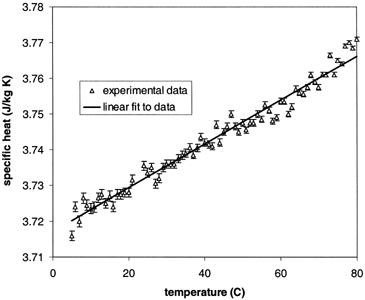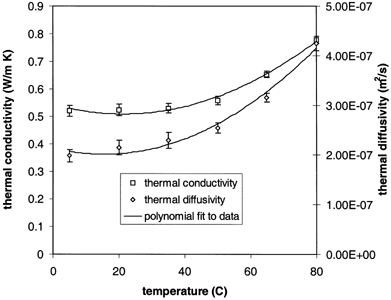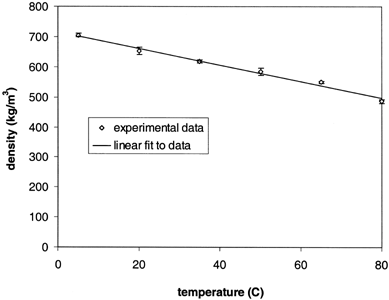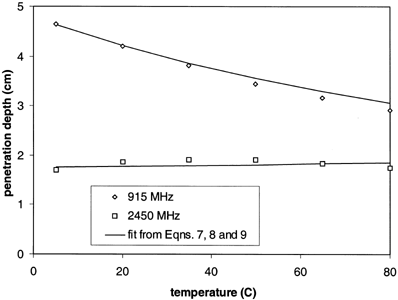Abstract
Pureeing of sweetpotato (SP) is carried out to enhance the conversion of the roots into value‐added products. During processing, production and home utilization, the puree is often heated (conventional cooking or microwaved), hence the need to measure the corresponding properties of SP puree. Thermal (specific heat, thermal conductivity, density, and thermal diffusivity) and dielectric properties (dielectric constant and dielectric loss factor) of SP puree were determined within a temperature range of 5 to 80°C. Increase in temperature increased the specific heat (3.70–3.78 kJ/kg K), thermal conductivity (0.52–0.78 W/m K), and thermal diffusivity (1.98 × 10−7–4.25 × 10−7 m2/s) of SP puree. The density (705–485 kg/m3) of the puree decreased with temperature. Both temperature and frequency (900–2500 MHz) significantly affected the dielectric constant (60.5–73.0) and dielectric loss factor (16.5–29.5) of SP puree. At the two frequencies (915 and 2450 MHz) used in industrial food processing, calculations showed that the penetration depth was not significantly affected by temperature at 2450 MHz, while at 915 MHz, the penetration depth decreased with temperature.
Introduction
The industrial utilization of sweetpotatoes (SP) often involves processing of the roots into puree. Some products that can be derived from the SP puree include simulated French‐fries,Citation[1] restructured baked products,Citation[2] SP patties,Citation[3] and baby foods.Citation[4] These SP puree‐derived products are cooked and heated in a conventional oven or microwaved before they are consumed. Thermal and dielectric properties of SP puree will be crucial to the design and development of operations needed to heat these products.
Thermal properties (specific heat, thermal diffusivity, and thermal conductivity) of biological materials are used to analyze and simulate the rate and amount of heat transfer and for the design of processing equipment. Specific heat (c) is a measure of the ability of a material to store thermal energy.Citation[5] Thermal conductivity (k) represents the rate at which heat is conducted into or out of a material.Citation[6] Thermal diffusivity (α) is related to other thermal properties as below:
Dielectric properties are important in product development and food process engineering because they influence the way in which electromagnetic fields associated with microwave energy interact with a material.Citation[9] For practical use, the dielectric properties of importance are the dielectric constant (ϵ′) and the dielectric loss factor (ϵ″). The dielectric constant represents the capability for storing energy in the electric field in the material, while the dielectric loss is associated with the dissipation of electric energy in the material by conversion of electric energy into heat. The ratio of ϵ″ to ϵ′ is the loss tangent (tan δ), is an index of energy dissipation or loss in a material exposed to microwave electric fields.Citation[10] Citation[11] Several studies have shown that dielectric properties of biological materials are affected by frequency, product temperature, material composition, and density.Citation[12] Data are available for the dielectric properties of basic food and agricultural materials,Citation12–14 especially at 915 and 2450 MHz (the frequencies generally employed in industrial food processing). To our knowledge, there is no known study that has been carried out on the thermal and dielectric properties of SP puree. The aim of this study was to determine the thermal and dielectric properties of SP puree and to quantify the effect of temperature (5–80°C) on these properties.
Materials and Methods
Sample Preparation
Raw SP roots (Beauregard cultivar) that have been cured and stored at 13–16°C and 80–90% relative humidity for four months were used in this study. The roots were made into puree using the method described by Truong et al.,Citation[1] except that the roots were hand‐peeled instead of lye‐peeled. The peeled roots were cut into slices (0.95 cm thick) and steam‐cooked for 20 min. The cooked slices were then pureed using a hammer mill (model D, Fitzpatrick Co., Chicago, IL) fitted with a 0.15 cm screen. Pureed samples were packaged into polyethylene bags and stored in the refrigerator for experimental measurements. Moisture content of the puree was 73.3% (wet basis) and was determined by placing 10 g samples in an air‐convection oven set at 103°C for 24 h.
Thermal Properties Measurement
Specific heat was measured by means of a Perkin‐Elmer DSC 7 differential scanning calorimeter equipped with an intracooler II refrigeration unit and dry box (Perkin Elmer Corp., Norwalk, CT). The DSC was calibrated with indium (temperature and enthalpy) and dodecane (temperature) before use. Sweetpotato puree samples were weighed (30 mg) in the manufacturer's stainless steel pans and run from 5 to 80°C at a heating rate of 3°C/min using an empty pan as the reference. Specific heat was calculated by the software provided by the DSC manufacturer. To ascertain the accuracy of the measurements, the specific heat of HPLC‐grade water was measured and found to be within 2% of published values.Citation[15]
Thermal conductivity was determined by the line‐heat source probe method. The probe apparatus, constructed according to the recommendations of Sweat,Citation[16] consisted of a type E thermocouple (0.051 mm diameter), constantan heater wire (0.077 mm diameter), a 23‐gauge stainless steel hypodermic needle (houses the heater wire and thermocouple) and a type E thermocouple connector. To test a sample, a 150 mL beaker containing SP puree was placed in a controlled temperature water bath (Model RTE‐111, Neslab Instruments Inc., Newington, NH). The sample was then allowed to equilibrate to the desired temperature. After equilibration, the thermal conductivity probe was inserted into the sample and the power for the heater wire in the probe was turned on. Time and temperature data were recorded by a datalogger (OM‐3000, Omega Engineering Inc., Stamford, CT) at the rate of five readings per second. Thermal conductivity was calculated from the relation:Citation[16]
In order to be able to calculate the thermal diffusivity from EquationEq. (1), the density of SP puree must be determined. This was achieved by extruding the puree into a known weight stainless steel cylinder (D = 19 mm and L = 178 mm) using a sausage stuffer with horn diameter of 12.4 mm.Citation[17] The cylinder (with samples inside) were then placed in the controlled temperature water bath and allowed to expand freely during equilibration with the water in the bath. At each temperature, the excess puree was trimmed and the sample weighed using a Mettler balance. Density was calculated from the ratio of weight of sample in the cylinder to the volume of the cylinder. Three replicates were used for each temperature level.
Dielectric Properties Measurement
An HP 85070 dielectric probe kit (Hewlett Packard, Santa Clara, CA) was used to measure the dielectric properties of SP puree at frequencies of 900 to 2500 MHz (at every 2 MHz) and at temperatures of 5 to 80°C. The kit consists of an open‐ended, 3.6 mm diameter, semi‐rigid, Teflon‐insulated coaxial line with copper conductors connected to a network analyzer (Model 8510B, Hewlett Packard, Santa Clara, CA). The network analyzer measured the reflection coefficient at the probe‐sample interface. The software provided by the manufacturer of the dielectric probe was used to calculate the dielectric properties of SP puree.
Before the test, a cylindrical plastic container containing 400 g sample was placed in the controlled temperature water bath. When the desired temperature was reached, the container was removed from the water bath, and the dielectric properties were measured. The change in sample temperature before and after dielectric properties measurement was measured to be less than 1°C. The measurement system was calibrated using a standard short‐air distilled water. All measurements were carried out in duplicate. Deviations in measured values due to measurement error are depicted as error bars in the figures showing the influence of temperature on thermal and dielectric properties of sweetpotato puree.
Results and Discussion
Specific Heat
Data on the influence of temperature on the thermal properties of sweetpotato puree are given in . Specific heat of the puree increased with temperature in a linear fashion although the change in the specific heat over the temperature range used in this study (5–80°C) was less than 0.1 kJ/kg K (3.70–3.78 kJ/kg K). Similar values were obtained by Stewart et al.Citation[18] for SP roots. This indicates that pureeing of SP did not affect its ability to store thermal energy. The linear response of specific heat with temperature is also similar to the response that has been reported for most moist foods.Citation[16] The experimentally obtained values were related to temperature () by using the GLM regression procedure in a statistical software.Citation[19]
Table 1. Thermal properties of sweetpotato puree at temperatures of 5°C to 80°C
Thermal Conductivity
As expected for homogenous foods,Citation[20] thermal conductivity of SP puree generally increased with increase in temperature (). However, the change in k at the lower temperature values (5–35°C) was very small. Similar behavior was observed by AbuDagga and KolbeCitation[17] for surimi pastes. At room temperature (20–25°C), pureeing did not affect the thermal conductivity of SP. Stewart et al.Citation[18] reported an average value of 0.54 W/m K for SP roots at 24°C. In this study, we measured k of puree to be 0.53 W/m K at 20°C. A polynomial Equation (19) was used to fit the experimentally obtained thermal conductivity to temperature ().
Density
shows that the density of SP puree decreased linearly [EquationEq. (5)] with increase in temperature. Similar response has been reported for most food materialsCitation[17] Citation[21] and for fruit puree.Citation[22] Sweetpotato puree contains about 25% (dry basis) starch.Citation[23] When starch granules are heated in the presence of water, they imbibe water and increase in size.Citation[24] We believe this is responsible for the reduction in density of SP puree with temperature.
Thermal Diffusivity
The response for thermal diffusivity of SP puree with temperature was similar to that obtained for thermal conductivity (). Thermal diffusivity at each temperature was obtained by employing EquationEqs. (1) and Equation(5). In comparison to the data reported by Stewart et al.,Citation[18] thermal diffusivity of SP puree was two to four times that of the roots. This is primarily due to the reduction in density of the puree during heating. The polynomial equation below was used to fit thermal diffusivity of the puree to temperature.
Dielectric Properties
The effects of temperature and frequency on the dielectric constant and dielectric loss of SP puree are given in and . The values of both properties are within the range that has been reported for other food materialsCitation[25] Citation[26] and were generally about 10–15% higher than those reported for mashed potatoes.Citation[27] Citation[28] Dielectric constant exhibited the expected decrease with increase in both temperature and frequency.Citation[29] At temperatures of 5 and 20°C, the loss factor initially decreased, reached a minimum, and then increased with increase in frequency. Nelson and DattaCitation[25] explained that this response is caused by ionic conductivities at the lower frequencies by bound water relaxation and by the relaxation of free water near the top of the frequency range. At 35°C and higher, the loss factor only decreased with increase in frequency. This is an indication that at the higher temperature levels, ionic conductivity is predominantly responsible for loss factor of the puree.Citation[29] Dielectric constant and loss factor were mathematically related to temperature and frequency as follows:
Figure 4. Dielectric constants of sweetpotato puree at temperatures of 5 to 80°C and frequencies of 900 to 2500 MHz.
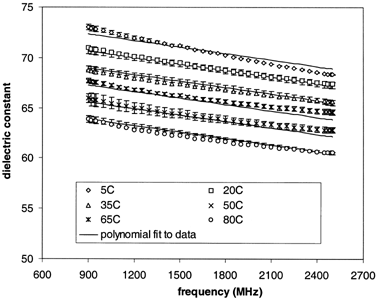
Figure 5. Dielectric loss factor for sweetpotato puree at temperatures of 5 to 80°C and frequencies of 900 and 2500 MHz.
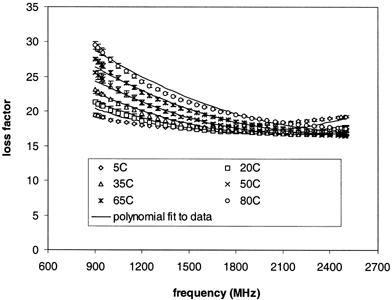
Penetration depth, the depth in a product at which the microwave power is decreased to 1/e (or 37%) of its value at the surface of the material, is important in the characterization of the microwave power absorption of a material. Penetration depth is given by Ref.Citation[33].
Conclusions
Based on the results obtained from this study, it can be concluded that:
| a. | The thermal properties of SP puree are significantly affected by temperature (5–80°C). Specific heat and density of the puree, respectively, increased and decreased with temperature in a linear fashion. Polynomial equations were used to relate both thermal conductivity and thermal diffusivity of the puree to temperature. | ||||
| b. | Dielectric constant and dielectric loss factor were significantly affected by both temperature (5–80°C) and frequency (900–2500 MHz). Dielectric constant linearly reduced with increasing temperature and decreasing frequency. There was interaction between temperature and frequency effects on the dielectric loss factor. | ||||
| c. | At 915 MHz, the penetration depth decreased with temperature, while at 2450 MHz temperature only slightly affected the penetration depth. At any temperature, penetration depth was always greater at 915 MHz in comparison to 2450 MHz. | ||||
It is expected that the results from this study would be useful for designing equipment, processes and heating procedures during the value‐added utilization of SP puree.
Nomenclature
| c | = |
specific heat (kJ/kg C) |
| D | = |
penetration depth (cm) |
| f | = |
frequency (106 Hz) |
| k | = |
thermal conductivity (W/m C) |
| Q | = |
power (W/m) |
| T | = |
temperature (°C) |
| t | = |
time (s) |
| α | = |
thermal diffusivity (m2/s) |
| δ | = |
loss tangent |
| ϵ′ | = |
dielectric constant |
| ϵ″ | = |
dielectric loss factor |
| λ | = |
wavelength (cm) |
| ρ | = |
density (kg/m3) |
Acknowledgment
This work was supported in part by a research grant from Pickle Packers International, Inc., St. Charles, IL.
References
- Truong , V. D. , Walter , W. M. Jr. and Giesbrecht , F. G. 1995 . Texturization of sweetpotato puree with alginate: effects of tetrasodium pyrophosphate and calcium sulfate . J. Food Sci. , 60 : 1054 – 1059 .
- Truong , V. D. and Walter , W. M. Jr. 1994 . Physical and sensory properties of sweetpotato puree texturized with cellulose derivatives . J. Food Sci. , 59 : 1175 – 1180 .
- Silva , J. L. 1990 . Sweetpotatoes: Processing and Products , Southern Cooperative Series Bulletin 340 15 Mississippi State University .
- Woolfe , J. A. 1992 . Sweetpotato: An Untapped Food Resource 642 Cambridge , MA : Cambridge University Press .
- Incropera , F. P. and DeWitt , D. P. 1996 . Fundamentals of Heat and Mass Transfer, , 4th Ed. 886 New York : John Wiley and Sons .
- Singh , R. P. and Heldman , D. R. 1993 . Introduction to Food Engineering, , 2nd Ed. 499 New York : Academic Press .
- Mohsenin , N. N. 1980 . Thermal Properties of Food and Agricultural Materials 407 New York : Gordon and Breach Publishers .
- 1993 . “ Thermal properties of foods ” . In ASHRAE Handbook, Fundamentals 30.1 – 30.26 . Atlanta , GA : American Society of Heating, Refrigerating, and Air‐Conditioning Engineers . ASHRAE
- Nelson , S. O. 1994 . Measurement of microwave dielectric properties of particulate materials . J. Food Eng. , 21 : 365 – 384 .
- Nelson , S. O. 1996 . Review and assessment of radio‐frequency and microwave energy for stored grain insect control . Trans. ASAE , 39 : 1475 – 1484 .
- Tanaka , F. , Mallikarjunan , P. and Hung , Y. C. 1999 . Dielectric properties of shrimp related to microwave frequencies: from frozen to cooked stages . J. Food Proc. Eng. , 22 : 455 – 468 .
- Ryynanen , S. 1995 . The electromagnetic properties of food materials: a review of the basic principles . J. Food Eng. , 26 : 409 – 429 .
- Ohlsson , T. and Bengtsson , N. 2001 . Microwave technology of foods . Adv. Food Nutr. Res. , 43 : 65 – 140 .
- Mudgett , R. 1985 . “ Dielectric properties of foods ” . In Microwaves in the Food Processing Industry Edited by: Decareau , R. V. 15 – 37 . Orlando , FL : Academic Press .
- Weast , R. C. 1977 . Handbook of Chemistry and Physics Cleveland , OH : CRC Publisher .
- Sweat , V. E. 1986 . “ Thermal properties of foods ” . In Engineering Properties of Foods Edited by: Rao , M. A. and Rizvi , S. S.H. 49 – 87 . New York : Marcel Dekker Inc. .
- AbuDagga , Y. and Kolbe , E. 1997 . Thermophysical properties of surimi paste at cooking temperature . J. Food Eng. , 32 : 325 – 337 .
- Stewart , H. E. , Farkas , B. E. , Blankenship , S. M. and Boyette , M. D. 2000 . Physical and thermal properties of three sweetpotato cultivars (Ipomoea batatas L.) . Intern. J. Food Prop. , 3 : 433 – 446 .
- 2001 . Statistical Analysis System User's Guide: Statistics Cary , NC : SAS Institute Inc. . SAS
- Choi , Y. and Okos , M. R. 1986 . “ Thermal properties of liquid foods–review ” . In Physical and Chemical Properties of Food Edited by: Okos , M. R. 35 – 77 . St. Joseph , MO : ASAE .
- Urbicain , M. J. and Lozano , J. E. 1997 . “ Thermal and rheological properties of foodstuffs ” . In Handbook of Engineering Practice Edited by: Valentas , K. J. , Rotstein , E. and Singh , R. P. 427 – 488 . New York : CRC Press .
- Ramos , A. M. and Ibarz , A. 1998 . Density of juice and fruit puree as a function of soluble solids content and temperature . J. Food Eng. , 35 : 57 – 63 .
- Walter , W. M. Jr. and Schwartz , S. J. 1993 . Controlled heat processing of jewel sweetpotatoes for puree production . J. Food Qual. , 16 : 71 – 80 .
- Hoseney , R. C. 1994 . Principles of Cereal Science and Technology, , 2nd Ed. 378 St. Paul , MN : American Association of Cereal Chemists .
- Nelson , S. O. and Datta , A. K. 2001 . “ Dielectric properties of food materials and electric field interactions ” . In Handbook of Microwave Technology for Food Applications Edited by: Datta , A. K. and Anantheswaran , R. C. 69 – 114 . New York : Marcel Dekker Inc. .
- Nelson , S. O. , Forbus , W. R. Jr. and Lawrence , K. C. 1994 . Microwave permitivities of fresh fruits and vegetables from 0.2 to 20 GHz . Trans. ASAE , 37 : 183 – 189 .
- Regier , M. , Housova , J. and Hoke , K. 2001 . Dielectric properties of mashed potatoes . Intern. J. Food Prop. , 4 : 431 – 439 .
- Datta , A. K. , Sun , E. and Solis , A. 1995 . “ Dielectric property data and their composition‐based prediction ” . In Engineering Properties of Foods Edited by: Rao , M. A. and Rizvi , S. S.H. 657 – 695 . New York : Marcel Dekker Inc. .
- Buffler , C. R. 1993 . Microwave Cooking and Processing: Engineering Fundamentals for the Food Scientist 169 New York : Van Nostrand Reinhold .
- Fasina , O. O. , Walter , W. M. Jr. and Fleming , H. P. 2001 . Viscoelastic properties of sweetpotato puree . Intern. J. Food Sci. Tech. , in press
- Herve , A. G. , Tang , J. , Luedecke , L. and Feng , H. 1998 . Dielectric properties of cottage cheese and surface treatment using microwaves . J. Food Eng. , 37 : 389 – 410 .
- Ohlsson , T. 1989 . “ Dielectric properties and microwave processing ” . In Food Properties and Computer‐aided Engineering of Food Processing Systems Edited by: Singh , R. P. and Medina , A. G. 73 – 92 . The Netherlands : Kluwer Academic Publishers .
- Mudgett , R. E. 1995 . “ Electrical properties of foods ” . In Engineering Properties of Foods Edited by: Rao , M. A. and Rizvi , S. S.H. 389 – 455 . New York : Marcel Dekker Inc. .
